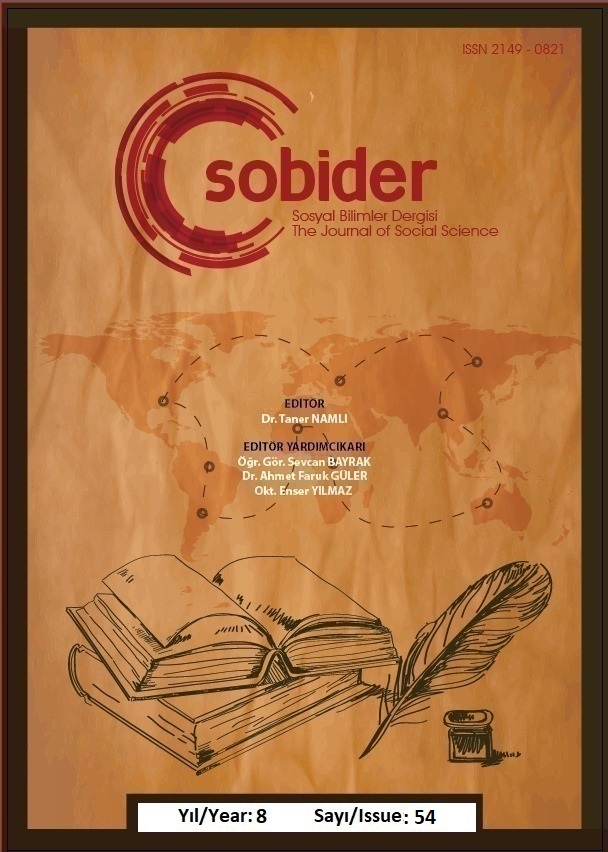ÜNLÜ MARKA LOGOLARININ (LOGOTYPE) BAŞKA DİLLERE UYARLANMASININ GÖRSEL ALGI AÇISINDAN DEĞERLENDİRİLMESİ
Author :
Abstract
Günümüzde özellikle uluslararası (ünlü) firmalar dünyanın her yerini, ticari açıdan sınırların olmadığı ürününü veya hizmetini satacağı bir pazar olarak görmektedir. Yoğun rekabet koşullarında müşterinin ürünü tercih etmesi için çok çeşitli stratejiler uygulamaktadır. Bu stratejilerin ilk aşaması ürüne ait görsel kimliğin tüketicilerde kolay algılanması ve bilinirlik oluşturmasıdır. Ürünün görsel kimliğinin algılanmasında dil ve alfabe farklılıkları sorun oluşturabilmektedir. Bu amaçla tipografik elemanlardan meydana gelen logolarını (logotype) o ülkenin diline ve alfabesine uyarlama yoluna gitmektedirler. Bu uyarlama işleminde en önemli unsur orjinalle en yakın görsel etkiyi elde etme çabası olmaktadır. Bir firmanın görsel kimliği, amblem ve logodan meydana gelebildiği gibi sadece amblemden veya sadece logodan meydana gelebilir. Uluslararası firmalar görsel kimliği o ülkenin insanları tarafından kolay algılanması için kullandıkları alfabeye göre logolarını oluşturma yoluna gitmektedirler. Bu işlemde en zor olan kısım firmanın diğer firmalardan ayrıştıran görsel kimliğinin özgün yapısını koruyabilmektir.
Dil ve alfabe uyarlamalarında; görsel kimlik hem amblemden hem de logodan meydana geliyor ise amblem değişmediği için algılamada büyük bir avantaj sağlamaktadır. Fakat sadece logodan meydana gelen görsel kimliklerde yazı dilinin ve alfabenin değişmesi yeni bir görsel olarak algılanabilmektedir.
Çalışmada farklı dillere uyarlamaları olan uluslararası markalar arasından rastgele seçilen örnekler görsel algı kavramları açısından değerlendirilmiştir. Kişisel bakış açısı ile yapılan bu değerlendirmeler her türlü eleştiriye açıktır.
Keywords
Abstract
Today, especially international (famous) companies see every part of the world as a market without commercial boundaries for their products or services. It applies a wide variety of strategies for the customer to prefer the product under intense competition conditions. The first stage of these strategies is to easily perceive the visual identity of the product and create awareness among consumers. Language and alphabet differences can cause problems in perceiving the visual identity of the product. For this purpose, they adapt their logo (logotype), which consists of typographic elements, to the language and alphabet of that country. The most important element in this adaptation process is the effort to achieve the closest visual effect with the original. The visual identity of a company can consist of an emblem and a logo, as well as only the emblem or only the logo. International companies go to create their logos according to the alphabet they use so that the visual identity is easily perceived by the people of that country. The most difficult part in this process is to preserve the original structure of the visual identity of the company, which distinguishes it from other companies.
Language and alphabet adaptations; If the visual identity consists of both the emblem and the logo, it provides a great advantage in perception since the emblem does not change. However, in visual identities consisting of only the logo, the change of the written language and alphabet can be perceived as a new visual.
In the article, randomly selected samples from international brands with adaptations to different languages were evaluated in terms of visual perception concepts. These evaluations made from a personal point of view are open to all kinds of criticism.
Keywords
- Becer, E. (1997), İletişim ve Grafik Tasarım, Dost Kitabevi, Ankara.
- Çağlayan, S. Korkmaz, H. M. Öktem, G. (2014), Sanatta Görsel Algının Literatür Açısından Değerlendirlmesi, Eğitim ve Öğretim Araştırmaları Dergisi, Cilt:3 Sayı:1.
- Çakı, A. (2010), Türkiye’de Amblem–Logo Tasarımının Gelişim Süreci, Yayınlanmamış Yüksek Lisans Tezi. İstanbul: Haliç Üniversitesi SBE.
- Gassas, R. F. (2016), Best Practice in Adapting Logo Marks From Latin to Non-Latin Scripts: A Case Study in The Arabic Market, Anglia Ruskin University, Doctora Thesis. UK.
- MEGEP (2009), Yazılı Basında Yaratıcı Faaliyetler-2, Halkla İlişkiler ve Organizasyon Hizmetleri, Milli Eğitim Bakanlığı, Ankara.
- Özkirişçi, İ. H. (2020), Algı ve Zaman Bağlamında Grafik İmge, STD, Haziran.
- Teker, U. (2009), Grafik Tasarım ve Reklam, Dokuz Eylül Yayınları, İstanbul.
- Tuğrul, B., Aral, N., Erkan, S. ve Etikan, İ. (2001), Altı Yaşındaki Çocukların Görsel Algılama Düzeylerine Frostig Görsel Algı Eğitim Programının Etkisinin İncelenmesi, Journal of Qafqaz University, 8, 67–84. Web sitesi: http://www.qafqaz.edu.az (erişim tarihi: 26.01. 2021).
- Uçar, T. (2004), Görsel İletişim ve Grafik Tasarım, İnkılap Yayınevi, İstanbul.
- Uğur, E. (2019), Op-Art (Optik Sanat) Akımının Görsel Algı ve Grafik Tasarım Kavramları Açısından Tanımlanması, Iğdır Üniversitesi Sosyal Bilimler Dergisi, Sayı: 17.
- Uğur, E. & Özsoy S.A. (2020), Covid-19 Pandemi Sürecinde Sembolleşmiş Görsel Unsurların Görsel İletişim Tasarımı Açısından Değerlendirilmesi, Ulakbilge Sosyal Bilimler Dergisi, 50, s. 779–790. doi: 10.7816/ulakbilge-08-50-04.
- (URL1) https://tr.logaster.com/blog/tips/animals/create-puma-logo/ (erişim tarihi 15.09.2020)
- (URL2) http://www.alisverismerkezisusle.com/referans.html (erişim tarihi 12.05.2021)
- (URL3) https://www.shutterstock.com/search/visual+perception+icon (erişim tarihi 05.03.2021)
- (URL5) https://logos.fandom.com/wiki/Burger_King_(Russia) (erişim tarihi 01.02.2021)
- (URL6) https://www.redbubble.com/i/poster/Japanese-Burger-King-Logo-by- NoodleSoap/29601287.LVTDI (erişim tarihi 25.04.2021)
- (URL8) https://seeklogo.com/vector-logo/26382/carlsberg (erişim tarihi 20.10.2020)
- (URL9) https://www.deviantart.com/variantart123/art/Carlsberg-logo-Cyrillic-version- 762119274 (erişim tarihi 22.12.2020)
- (URL10) https://damirpolutranko.com/logos-and-their-non-latin-adaptations/ (erişim tarihi 16.04.2021)
- (URL11) https://seeklogo.com/vector-logo/32917/coca-cola (erişim tarihi 20.05.2021)
- (URL13)https://www.dreamstime.com/editorial-stock-image-coca-cola-ml-cans-arabic-version- image45353039 (erişim tarihi 18.11.2020)
- (URL16) https://metro.co.uk/2018/09/11/dominos-regrets-telling-customers-theyll-get- 100-years-of-pizza-if-they-tattoo-themselves-7933548/ (erişim tarihi 15.07.2021)
- (URL17) https://susieofarabia.blogspot.com/2016/05/our-world-dominos-in-arabic.html
- (URL20) https://www.travelblog.org/Photos/5947886 (erişim tarihi 18.03.2021)
- (URL21) https://www.lipton.com/tr/home.html (erişim tarihi 19.12.2020)
- (URL22) https://www.walmart.ca/en/ip/lipton-yellow-label-arabic-tea- bags/6000188764817 (erişim tarihi 08.07.2021)
- (URL23) https://www.theodmgroup.com/lipton-green-tea-china-offering-marketing- awards/ (erişim tarihi 22.04.2021)
- (URL24) https://www.nutella.com/tr/tr/ (erişim tarihi 27.01.2021)
- (URL27) https://www.pizzahut.com.tr/ (erişim tarihi 14.04.2021)
- (URL28) https://read01.com/Q3yBd3E.html (erişim tarihi 20.03.2021)
- (URL33) https://www.haberturk.com/subway-500-restoranini-kapatacak-1935744- ekonomi (erişim tarihi 10.07.2021)
- (URL35) https://thirdside.co/branding-across-languages/ (erişim tarihi 11.01.2021)





